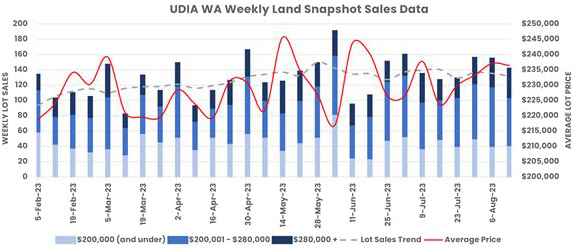Perth running out of greenfield land, facing 20,000 home shortfall
Perth is facing a drastic shortfall in new homes over the next couple of years but the city remains the most affordable for real estate investors looking for vacant blocks to develop.
The ‘Lucky Country’ is fast turning into the ‘Impossible Country’, as more and more people are struggling to find affordable and appropriate accommodation that suits the needs of their household.
UDIA WA has been sounding the alarm bells for years now in relation to the housing supply crisis that we currently find ourselves in, not just in Western Australia but across the country.
A lack of forward supply across the housing continuum, from crisis accommodation to social and affordable housing and into standard home ownership, has led to the situation we now find ourselves in.
Rental vacancy rates remain at record lows and established product supply on the market remains thin.
In Western Australia, UDIA WA just released its latest new residential land sales data for the June quarter 2023. On face value, the news looks more positive for the land development sector and forward supply.
The Urban Development Index (UDI) in June 2023 recorded a 45 per cent lift in new land sales volumes for the quarter, coupled with an increase in construction activity, as 15 per cent more lots are under construction for release in the next 12 months compared with last quarter.
The UDI is a quarterly survey of 22 major developers active in the Perth Metro Area and these latest figures represent an uplift in demand for new land from consumers.
Perth land remains affordable
The good news for prospective buyers is that Perth remains extremely affordable compared with the rest of the country, with the average price of new land sitting at $243,650, which is approximately 40 per cent cheaper than the combined capital city average.
The price of new land has managed to maintain relative stability for the last couple of years despite the constraints on supply and cost escalations in relation to materials and labour.

While prices are steady and demand remains strong as population growth continues, housing supply remains at critically low levels despite the lift in construction activity.
Construction activity slowed considerably during the market downturn in the years leading up to the pandemic, and while activity spiked after the building stimulus, there is a lot of ground to make up due to the chronic undersupply of housing to the market over an extended period.
Huge WA dwelling shortfall
To put the supply issues in perspective, new data suggests that WA could be facing a 20,000 dwelling shortfall over the next three years.
UDIA WA has analysed official data from the National Housing Finance Investment Commission (NHFIC) and found that based on projected household formation compared with annual net dwelling supply, there is a cumulative shortfall of around 20,000 dwellings statewide between 2023-2026.
We are also aware, based on our UDI survey respondents, that 25 current land estates in the Perth Metro Area will be completed and run out of lots by the end of next year. A further 16 will close out in 2025.
That means much of the ‘low hanging fruit’ in terms of supply of affordable, greenfield land is running out. Subsequently, forward land supply is reliant on complex infill and more constrained sites that take longer and are more expensive to bring to market.
Ensuring there is a sufficient supply of zoned and serviced new land estates will be a significant challenge over the coming two years.
The situation is alarming and requires a multi-faceted approach from both Federal and State Government to address the housing shortfall.
UDIA WA has already made several recommendations for State and Federal Government in relation to unlocking housing supply across the housing continuum. We are now drafting a Housing Crisis Action Plan that we will present to government in the coming weeks.
The recommendations we have already made, focus on minimising the cumulative impact of restrictive government policy and ensuring a strategic approach to infrastructure coordination and delivery that constrains supply from being brought to market.
Zoning changes welcomed
It has been promising that WA’s Minister for Planning, Lands, Housing and Homelessness John Carey has been willing to take immediate action since his appointment to the Planning portfolio in June.
In particular, the removal of lower density R30 from the new Medium Density Housing Code and its deferral to properly consider the implications on construction costs and delivery of affordable housing was welcomed by industry last week.
The State Government has also resolved the last two Planning Investigation Areas (PIAs) and allocated 600 hectares in Jandakot-Treeby and 235 hectares in north Ballajura for future urban expansion.
The finalisation of these PIAs takes away some of the uncertainty for developers in these areas and ensures there will be more land available to deliver much needed housing in these areas in the coming years.
In terms of infill and apartment development, there remains a range of complex challenges in the WA context in relation to getting medium and high density product to market.
The Minister has also recognised these issues and that was reflected in the recent decision to put in place interim measures for public open space (POS) contributions for infill development while a broader POS policy review is undertaken.
The interim measures will aim to reduce regulatory burden and cost for infill development and are an important sign that government is listening when it comes to ensuring government policy decisions are considered through a housing affordability lens.
Overall, the ability of governments at all levels to consider new policy and updates to existing policies in the context of housing supply and affordability is critical if we are to collectively respond to Western Australia’s housing needs effectively.





















